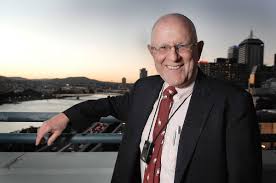Gordon Bell | Gödel’s Lost Letter and P=NP

Sadly Gordon Bell died May 17 at the age of 89, see this.
Bell died in Coronado, California from pneumonia. He was a true visionary in the world of computing who helped design some of the first minicomputers in the 1960s. Much will be written about his life and legacy, but his technical contributions were primarily in computer and system architecture. His impact on algorithms and theory are significant but may be less widely known.
Today Rich DeMillo and I wish to add to his memories from our own personal viewpoint. Rich especially interacted with Bell over the years and we hope he will add to the thanks that everyone has. This is mostly from his point of view.
Rich: Like many computer scientists whose careers began in the late 1960’s, my contact with Gordon was episodic. He was already a towering figure by the time Dick and I graduated. Some of us were more directly affected by his formidable presence than others. Dick was a graduate student at CMU, and, since Gordon deliberately blurred the line between DEC and CMU, he would have been steeped in the culture that promoted by Bell, Perlis, Simon, and Traub. Coincidentally, Perlis would also be an influence on both of us. Link to the GLL post on Social Processes. When I at NSF in the research directorate that founded, virtually everything I touched somehow reflected his view of that computational science should drive computing research, his work had a profound impact on supercomputer development when I was at HP because his high performance systems at DEC were acquired by HP in the Compaq merger.
DEC-CMU-DEC
Bell was working at the Speech Processing Lab at MIT at around the same time that Digital Equipment Corporation (DEC) was spun out of MIT Lincoln Labs by Ken Olson and Harlan Anderson, and joined DEC as the company’s first engineer. in 1960. His creation of the PDP-1 (Programmed Data Processor-1) line of minicomputers (computers of the time were expensive and enormous) instantly transformed data centers. The PDP line was mostly commercially successful, especially the later PDP-8 and PDP-10 machines which were ubiquitous in academic computer science and technical computing labs. The failed PDP-6 was an exception, but the PDP-10 used the same architecture with silicon semiconductors and was twice as fast. DEC dropped the price and sold 1,500 of these machines. After the launch of the Bell resigned form DEC after a disagreement with Olson, and joined the new academic computer science department at Carnegie Mellon University (CMU) here}.
From 1966 to 1972 Gordon was a professor of computer science and electrical engineering. He was perhaps the first to conceive computer architecture as a separate academic discipline, although he would not have approved of that characterization. Like many early computer designers, Bell was a tinkerer. A heart condition kept him close to the workshop of his father, an electrical and electronics repairman from second grade on. He was a computer designer, and his approach leaned heavily on his practical experience designing DEC’s PDP computers.
His famous textbook on computer architecture book had a long and storied life, beginning as collected readings and notes from the University of Michigan Press before Bell and Allen Newell collaborated on writing a textbook.
Bell and Olson mended fences, and Gordon returned to DEC in 1972 to create the famous VAX minicomputer. DEC sold approximately 400,000 VAXs during its 20-year production run from the 1970s to the 1990s. The VAX

put high performance technical computing on the desktops of engineers and scientists around the world. DEC continued to focus on high performance systems with the DEC Alpha, when Compaq purchased the company in 1998 and was in turn acquired by HP in 2001.
Bell’s Law
Everyone is familiar with is familiar with the law attributed to Gordon Moore (the founder of Fairchild Semiconductors) which states that the density of transistors on a chip doubles every 18 months, which halves the cost of semiconductors every 18 month. Moore’s Law is generally used to explain why the the capability of computers at a fixed cost doubles every 18 months The pace of chip manufcturing has slowed in recent years, so these days the doubling rate is closer to 24 months. It sounds technical, but in reality Moore’s Law is about money. Today, transistor density is still going up, but so is the price of semiconductors, which means that Moore’s Law is increasingly out of step with what drives costs in computing hardware.
Gordon Bell other} Gordon formulated Bell’s Law, which is not as famous at Moore’s but is more applicable to actual technology development because it is about systems, not transistors, and explains the emergence of media players, smartpjhones, tablets, cloud computing and more disruptive events A new lower priced class of computers emerges every decade based on disruptive advances in programming platforms, networks, and interfaces, which result in new use cases and the establishment of a new industry.
NSF
In 1986, he became Assistant Director of the National Science Foundation, where he founded the Computer and Information Science and Engineering Directorate. This was a time of upheaval and excitement in computer related research funding, and Bell played a major role in constructing today’s research infrastructure Tennessee Senator Al Gore was intrigued by the concept of an “information super highway”. Although we was roundly mocked in political circles, Gore was influenced by supercomputer development at Oak Ridge National Labs and began policy discussions in linking together labs, super computing facilities, and communication networks. In response, Congress set up cross-agency working groups to examine how this might be done. One of Bell’s roles in the new organziation at NSF was to ensure coordination among the various groups and agencies. By that time he had already formulated Bell’s Law and used his technical and persuasive skills—Which sometimes had the force of a battering ram to those on the other side of an argument to convince skeptical committee heads of the need ensure the health of the high performance computing industry.
The Gordon Bell Prize
One way to look at Bell’s Law is that improved performance and scalability are the result of intertwining of hardware and software innovation applied to increasingly difficult challenges in technical computing. That philosophy was enshrined in the Gordon Bell Prize, awarded annually by the ACM for achievement in technical parallel computing. The prize grew out of a letter from then IBM-numerical analyst Alan Karp to the editor of Communications of the ACM (CACM). wondered in print whether massively parallel MIMD processors was the best way to execute numerical algorithms and offered 100 dollar prize for convincing evidence otherwise. Karp said it was large enough to get attention but not so large to be a burden to pay if, as he suspected, someone would actually win it. Gordon liked the idea of a challenge that would track progress in parallel computing and endowed a $10,000 annual prize to be awarded for fundamental scientific breakthroughs with these goals:
* Reward practical use of parallel processors;
* Encourage improvements in hardware and software;
* Demonstrate the usefulness of parallel processors for real problems.
The first prize was awarded for work showing that Ahmdahl’s Law states that the overall speedup due to parallelism is limited by the proportion of code that cannot be parallized. In the 1967 AFIPS Spring Joint Computer Conference Amdahl stated and proved a result showing this in principle, there were proposals for alternative parallel architectures that could avoid the limitation. may not be insurmountable.
Over the years many contributions have been recognized by the Bell Prize.
This year’s Gordon Bell Prize was given to an International Team for Materials Simulations Which Achieve Quantum Accuracy at Scale. This work proposed a new framwork for ab initio real-time simulations. Quoting from the award citation: Despite the successes of ab initio approaches in a wide range of computer simulations, the team notes that efforts to employ quantum mechanical ab initio methods to predict materials’ properties has not been able to achieve quantum accuracy and scale on the powerful supercomputers needed to perform these simulations.
Microsoft, Silicon Valley, and Vanguard
The many published tributes to Bell’s life and career discuss his time in Silicon Valley, where he founded Microsoft’s Silicon Valley Laboratory. His book on capturing physical memory in digital form was one of his final works aimed at extending Bell’s Law to new applications such as nano-scale cardiac monitoring devices that could be woven into clothing.
Colleagues often remarked how easily Gordon slipped into his role a senior technologist during his years in Silicon Valley. Despite a reputation for being gruff, he was a personable and kind colleague. He helped Rich get situated when he moved from New Jersey to Palo Alto. Bell drove his Porsche 911 well into his 70’s. When he attended meetings at the San Jose Fairmont Hotel, the staff made sure it was parked in a visible location.
The gruff reputation was not entirely unearned, however. In the 1990’s Bell joined with other tech pioneers like Bell Labs’ Bob Lucky, UCLA’s Len Kleinrock, and MIT Media Lab’s Nicholas Negroponte to run a membership program called TTI Vanguard that had been spun out of Computer Science Corporation. Five times a year this wandering group of a hundred or so executives invited interesting high profile speakers to discuss candidly new results and innovations. Both of us attended regularly. The only rule of the Vanguard meetings was that the speaker must be given a ten-minute head start. At the ten-minute mark, Bell would inevitably be the first person to raise an interesting (and sometimes annoying) question or pose a problem that the speaker had overlooked. It was designed to be uncomfortable, and usually resulted in Gordon placing a bet on the other side of the speaker’s argument. The most memorable such encounter was Clayton Christensen’s presentation of The Innovator’s Dilemma. Christensen used the development of the PDP minicomputers as a case study for his theory that existing, successful tech companies are susceptible to innovation that takes them by surprise and eventually makes them obsolete. Bell did not give him the usual safety zone, He jumped to his feet, saying “I was there! It didn’t happen that way!” Christensen was a mild-mannered academic and completely unprepared for the assault. It was simultaneously the most uncomfortable and most entertraining such exchanges of all the Vanguard conferences.
More
Rich will add more in the future about Bell. We hope you enjoy these insights already.




